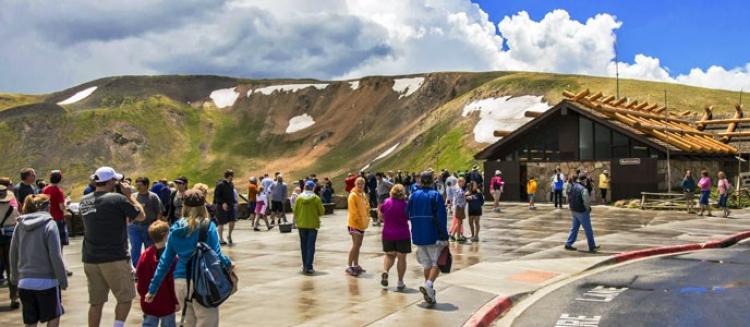Grad students’ capstone project aims to help Rocky Mountain National Park
As park usage rises, CU Boulder grad students join effort to manage the growth
Four University of Colorado Boulder graduate students spent their summer working at one of the nation’s premier national parks—Rocky Mountain National Park—as part of their capstone project in the Masters of the Environment Graduate Program.
John Hannon, management specialist for business programs at the park, has managed student groups, including those from the National Park Service’s intern program and Colorado State University, but this is the first time he’s worked with CU Boulder students.

Park visitors at the Alpine Visitor Center on Trail Ridge Road. Photo courtesy of NPS. At the top of the page, Longs Peak, the highest point in the park, is framed by fog and a sharp ridge.
Many of the programs crucial to the visitor experience at Rocky Mountain National Park, such as alternative transportation and commercial services, have recently been brought to the forefront by the strain of increasing park usage, according to Hannon. And it’s an opportunity he thinks these students can help fix.
“It’s really good because they bring an outside perspective and a new perspective,” said Hannon.
The Masters of the Environment (MENV) program requires students to complete a capstone project (which can be completed as a team), instead of the thesis or practicum requirements of many traditional masters’ programs.
Some of the students pick a team then decide on a program, but Kirsta Tortorice, Stephanie Reifenberg, Alison Dietze and Bridger Tomlin picked the project before the team.
The program routinely holds networking events to meet with potential partners for grad students, which is where the team met Hannon and learned about his project.
“For us, we met John (Hannon), and the rest was history,” said Reifenberg, a Michigan native who is concentrating on land management and wildlife.
“Some teams are formed by who wants to be in the project, and some by who wants to work together,” said Dietze, who is focusing more on sustainability. “We all just very lucky we work so well together.”
“The park has seen a 1.5 million increase in (annual) visitors since 2012,” said Hannon. “Naturally, the park didn’t get any bigger, and the roads didn’t either.”
“Given the career interests of this team, working alongside agency staff at Rocky Mountain National Park is an unparalleled opportunity to learn about the challenges and opportunities facing public lands managers while also developing professional skills,” said Instructor Lydia Lawhon, the advisor for the project.
This experience is a little different for each student, but they all share one thing: their interest in learning new skills from those that make the Rocky Mountain National Park a great place, and figuring out how they can use established skills to make it even better for visitors.
The project “is super interesting because I have a love of national parks, and it’s interesting to experience from both perspectives (as a park visitor and manager),” said Tortorice, a graduate of Endicott College in Massachusetts who came to CU Boulder specifically to work on policy and public land management issues.
Tomlin, a Boulder native who graduated from Maine’s Bowdoin College with a degree in environmental studies and history, agrees.
“I wanted to go to grad school in urban or environmental planning, and it’s hard to find the unique blend of policy, hard science and social science that’s here (at CU Boulder),” Tomlin said. “What got me excited about this project is the opportunity to work with a project that’s close to home, and being able to visualize the impact to the location.”
“Working with asset management is transferable to any field,” Tomlin said. “This is a very useful experience, especially in project scoping.”
The work has just begun for the project, according to Hannon, and any policy suggestions will go through National Park Service staff and its extensive public input process.
“I think we have some pretty specific goals, and we’ve designed this project to where they have the right amount of time to reach them (policy suggestions),” he said.
As for the grad students, finding themselves in a team doesn’t present any problems as the program makes them work together frequently.
“To be involved in this (program at the national park) is really awesome,” said Reifenberg.

